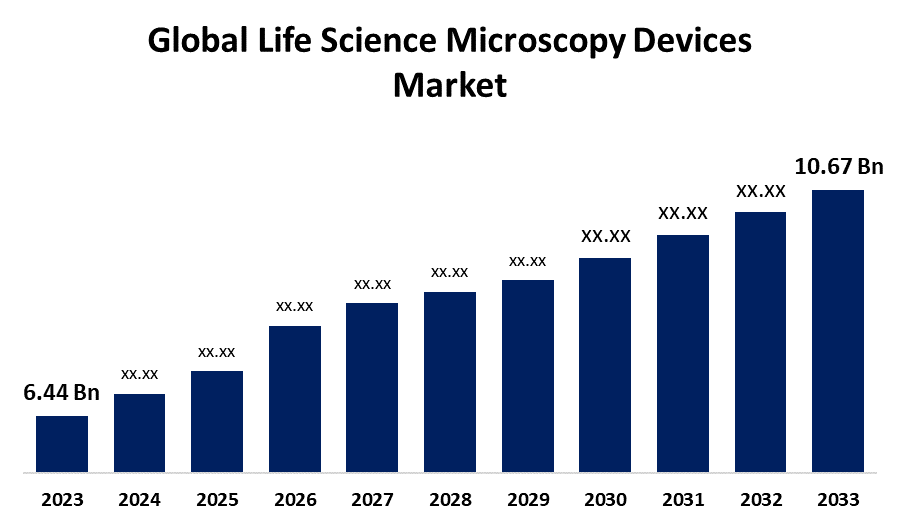Global Life Science Microscopy Devices Market Size, Share, and COVID-19 Impact Analysis, By Product Type (Optical Microscopes, Electron Microscopes, Scanning Probe Microscope, Confocal Microscopes and Fluorescence Microscopes), By End User (Research Laboratories and Institutes, Forensic and Diagnostic Laboratories, and Pharmaceutical and Biotechnology Companies), and By Region (North America, Europe, Asia-Pacific, Latin America, Middle East, and Africa), Analysis and Forecast 2023 - 2033.
Industry: HealthcareGlobal Life Science Microscopy Devices Market Insights Forecasts to 2033
- The Global Life Science Microscopy Devices Market Size was estimated at USD 6.44 Billion in 2023
- The Market Size is Expected to Grow at a CAGR of around 5.18% from 2023 to 2033
- The Worldwide Life Science Microscopy Devices Market Size is Expected to Reach USD 10.67 Billion by 2033
- Asia Pacific is expected to Grow the fastest during the forecast period.

Get more details on this report -
The Global Life Science Microscopy Devices Market Size was worth around USD 6.44 Billion in 2023 and is predicted to Grow to around USD 10.67 Billion by 2033 with a compound annual growth rate (CAGR) of 5.18% between 2023 and 2033. The life science microscopy equipment market is propelled by developments in microscopy technology, growing R&D expenditure, rising incidence of chronic diseases, expansion in biotechnology and pharma, integration of AI, precision medicine, and development of research infrastructure in emerging economies.
Market Overview
The life science microscopy devices is industry encompasses the designing, manufacturing, and selling of microscopes and associated imaging equipment for the analysis of biological specimens. These tools are critical to applications in biomedical research, clinical diagnostics, pharmaceutical development, and life sciences education, providing high-resolution imaging of cells, tissues, and microorganisms. In addition, the growing incidence of chronic illnesses such as cancer and neurodegenerative disorders is a driving force behind the need for life science microscopy instruments. As the importance of early diagnosis and personalized treatment grows for treating these conditions, there's an escalating need for sophisticated imaging instruments. Pathology laboratories are highly dependent on microscopes so that pathologists can analyze biopsy samples with improved accuracy and diagnose malignancies in their initial stage. Continuing innovation and the availability of increasingly easier-to-use interfaces are assisting in overcoming many of the existing problems in the life science microscopy space. As technology evolves and biomedical research expands, the worldwide market for life science microscopy equipment will experience robust and long-term growth.
Report Coverage
This research report categorizes the life science microscopy devices market based on various segments and regions, forecasts revenue growth, and analyzes trends in each submarket. The report analyses the key growth drivers, opportunities, and challenges influencing the life science microscopy devices market. Recent market developments and competitive strategies such as expansion, type launch, development, partnership, merger, and acquisition have been included to draw the competitive landscape in the market. The report strategically identifies and profiles the key market players and analyses their core competencies in each sub-segment of the life science microscopy devices market.
Global Life Science Microscopy Devices Market Report Coverage
| Report Coverage | Details |
|---|---|
| Base Year: | 2023 |
| Market Size in 2023 : | USD 6.44 Billion |
| Forecast Period: | 2023-2033 |
| Forecast Period CAGR 2023-2033 : | 5.18% |
| 2033 Value Projection: | USD 10.67 Billion |
| Historical Data for: | 2019-2022 |
| No. of Pages: | 220 |
| Tables, Charts & Figures: | 100 |
| Segments covered: | By Product Type (Optical Microscopes, Electron Microscopes, Scanning Probe Microscope, Confocal Microscopes and Fluorescence Microscopes), By End User (Research Laboratories and Institutes, Forensic and Diagnostic Laboratories, and Pharmaceutical and Biotechnology Companies), and By Region (North America, Europe, Asia-Pacific, Latin America, Middle East, and Africa) |
| Companies covered:: | Olympus Corporation, Nikon Corporation, Bruker Corporation, JOEL Ltd., FEI Company, Hitachi High-Technologies Corporation, Leica Microsystems, Carl Zeiss Microscopy, Cameca SAS, NT-MDT, and Others |
| Pitfalls & Challenges: | COVID-19 Impact, Challenges, Future, Growth, & Analysis |
Get more details on this report -
Driving Factors
The rising world incidence of chronic illnesses, including cancer, diabetes, and neurological disorders, is the key driver. Microscopy has a central role to play in the diagnosis and early detection of such ailments. Moreover, the persistent evolution of microscopy technologies is spearheading market development. Technologies such as super-resolution microscopy, live-cell imaging, and confocal fluorescence microscopy enable researchers to analyze biological samples more precisely and detail than ever. These technologies are creating new possibilities for research in molecular biology, genetics, and neuroscience, stimulating the need for cutting-edge microscopy systems.
Restraining Factor
One of the most significant challenges in the life science microscopy market is the expensive nature of sophisticated microscopes, including electron and confocal microscopes. These instruments are prohibitively pricey, with acquisition, installation, and customized maintenance contributing substantially to monetary burdens. This may restrict access to these technologies, particularly for small research organizations, developing nations, and startups that may lack sufficient funding.
Market Segmentation
The life science microscopy devices market share is classified into product type and end user.
- The optical microscopes segment dominated the market in 2023 and is projected to grow at a substantial CAGR during the forecast period.
Based on the product type, the life science microscopy devices market is divided into optical microscopes, electron microscopes and scanning probe microscopes, confocal microscopes, and fluorescence microscopes. Among these, the optical microscopes segment dominated the market in 2023 and is projected to grow at a substantial CAGR during the forecast period. The segmental growth is due to optical microscopes are the most common type of microscope used in research laboratories and clinical diagnostics. They are crucial for the study of cellular structures, tissues, and microorganisms in a range of disciplines, such as biological research, medical diagnostics, and education. Their versatility and relatively lower cost than other forms of microscopes make them the preferred choice for most institutions.
- The research laboratories and institutes segment accounted for a significant share in 2023 and is anticipated to grow at a remarkable CAGR during the forecast period.
Based on the end user, the life science microscopy devices market is divided into research laboratories and institutes, forensic and diagnostic laboratories, and pharmaceutical and biotechnology companies. Among these, the research laboratories and institutes segment accounted for a significant share in 2023 and is anticipated to grow at a remarkable CAGR during the forecast period. The growth is attributed to these institutions span a broad array of disciplines such as cell biology, neuroscience, microbiology, immunology, and developmental biology. All of these disciplines necessitate customized microscopy techniques for the imaging of intricate biological systems, which results in sustained and varied demand for a wide range of microscopy equipment.
Regional Segment Analysis of the Life Science Microscopy Devices Market
- North America (U.S., Canada, Mexico)
- Europe (Germany, France, U.K., Italy, Spain, Rest of Europe)
- Asia-Pacific (China, Japan, India, Rest of APAC)
- South America (Brazil and the Rest of South America)
- The Middle East and Africa (UAE, South Africa, Rest of MEA)
North America is anticipated to hold the largest share of the life science microscopy devices market over the predicted timeframe.

Get more details on this report -
North America is anticipated to hold the largest share of the life science microscopy devices market over the predicted timeframe. North America, particularly the United States, has a strong focus on biomedical and life sciences research. Government institutions like the National Institutes of Health (NIH) offer significant funding, backing thousands of projects in cell biology, genetics, and immunology. Such a high investment creates ongoing demand for sophisticated microscopy equipment to investigate intricate biological processes at the cellular and molecular level.
Asia Pacific is expected to grow at a rapid CAGR in the life science microscopy devices market during the forecast period. Asian Pacific countries, especially China, India, Japan, and South Korea, are investing heavily in the life sciences industry. Government initiatives such as China's "Made in China 2025" and India's "Biotechnology Industry Research Assistance Council (BIRAC)" are fueling biomedical research and healthcare infrastructure development. These investments are converting into increased usage of advanced research tools like life science microscopy equipment in universities, laboratories, and hospitals.
Competitive Analysis:
The report offers the appropriate analysis of the key organizations/companies involved within the life science microscopy devices market, along with a comparative evaluation primarily based on their type of offering, business overviews, geographic presence, enterprise strategies, segment market share, and SWOT analysis. The report also provides an elaborative analysis focusing on the current news and developments of the companies, which includes type development, innovations, joint ventures, partnerships, mergers & acquisitions, strategic alliances, and others. This allows for the evaluation of the overall competition within the market.
List of Key Companies
- Olympus Corporation
- Nikon Corporation
- Bruker Corporation
- JOEL Ltd.
- FEI Company
- Hitachi High-Technologies Corporation
- Leica Microsystems
- Carl Zeiss Microscopy
- Cameca SAS
- NT-MDT
- Others
Key Target Audience
- Market Players
- Investors
- End-users
- Government Authorities
- Consulting And Research Firm
- Venture capitalists
- Value-Added Resellers (VARs)
Recent Development
- In May 2024, Danaher launched the VIVENTIS LS2, a light sheet microscopy system capable of taking high-depth images of live samples. This innovation boosts live-cell imaging applications, making it the best tool for researchers interested in live biological processes in real time.
Market Segment
This study forecasts revenue at global, regional, and country levels from 2023 to 2033. Spherical Insights has segmented the life science microscopy devices market based on the below-mentioned segments:
Global Life Science Microscopy Devices Market, By Product Type
- Optical Microscopes
- Electron Microscopes
- Scanning Probe Microscope
- Confocal Microscopes
- Fluorescence Microscopes
Global Life Science Microscopy Devices Market, By End User
- Research Laboratories and Institutes
- Forensic and Diagnostic Laboratories
- Pharmaceutical and Biotechnology Companies
Global Life Science Microscopy Devices Market, By Regional Analysis
- North America
- US
- Canada
- Mexico
- Europe
- Germany
- UK
- France
- Italy
- Spain
- Russia
- Rest of Europe
- Asia Pacific
- China
- Japan
- India
- South Korea
- Australia
- Rest of Asia Pacific
- South America
- Brazil
- Argentina
- Rest of South America
- Middle East & Africa
- UAE
- Saudi Arabia
- Qatar
- South Africa
- Rest of the Middle East & Africa
Frequently Asked Questions (FAQ)
-
1. What is the CAGR of the life science microscopy devices market over the forecast period?The global life science microscopy devices market is projected to expand at a CAGR of 5.18% during the forecast period.
-
2. What is the market size of the life science microscopy devices market?The global life science microscopy devices market size is expected to grow from USD 6.44 Billion in 2023 to USD 10.67 Billion by 2033, at a CAGR of 5.18% during the forecast period 2023-2033.
-
3. Which region holds the largest share of the life science microscopy devices market?North America is anticipated to hold the largest share of the life science microscopy devices market over the predicted timeframe.
-
1. What is the CAGR of the life science microscopy devices market over the forecast period?The global life science microscopy devices market is projected to expand at a CAGR of 5.18% during the forecast period.
-
2. What is the market size of the life science microscopy devices market?The global life science microscopy devices market size is expected to grow from USD 6.44 Billion in 2023 to USD 10.67 Billion by 2033, at a CAGR of 5.18% during the forecast period 2023-2033.
-
3. Which region holds the largest share of the life science microscopy devices market?North America is anticipated to hold the largest share of the life science microscopy devices market over the predicted timeframe.
Need help to buy this report?